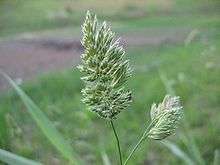Commelinids
In plant taxonomy, commelinids (originally commelinoids[1][2]) (plural, not capitalised) is an APG IV system named clade within the monocots within the angiosperms, distinguished by cell walls containing ferulic acid.[3][4]
| Commelinids | |
|---|---|
 | |
| Cock's-foot grass (Dactylis glomerata) | |
| Scientific classification | |
| Kingdom: | Plantae |
| Clade: | Tracheophytes |
| Clade: | Angiosperms |
| Clade: | Monocots |
| Clade: | Commelinids |
| Orders | |
| Diversity | |
| About 1,420 genera | |
The commelinids are the only clade that the APG has informally named within the monocots. The remaining monocots are a paraphyletic unit. Also known as the commelinid monocots it forms one of three groupings within the monocots, and the final branch, the other two groups being the alismatid monocots and the lilioid monocots.
Description
Members of the commelinid clade have cell walls containing UV-fluorescent ferulic acid.[3][4]
Taxonomy
The commelinids were first recognized as a formal group in 1967 by Armen Takhtajan, who named them the Commelinidae and assigned them as a subclass to Liliopsida (monocots).[5] The name was also used in the 1981 Cronquist system. However, by the release of his 1980 system of classification, Takhtajan had merged this subclass into a larger one, and no longer considered to be a clade.
Takhtajan system
In the Takhtajan system treated this as one of six subclasses within the class Liliopsida (=monocotyledons). It consisted of:
- subclass Commelinidae
- superorder Bromelianae
- order Bromeliales
- order Velloziales
- superorder Pontederianae
- order Philydrales
- order Pontederiales
- order Haemodorales
- superorder Zingiberanae
- order Musales
- order Lowiales
- order Zingiberales
- order Cannales
- superorder Commelinanae
- order Commelinales
- order Mayacales
- order Xyridales
- order Rapateales
- order Eriocaulales
- superorder Hydatellanae
- order Hydatellales
- superorder Juncanae
- superorder Poanae
- order Flagellariales
- order Restionales
- order Centrolepidales
- order Poales
- superorder Bromelianae
Cronquist system
The Cronquist system treated this as one of four subclasses within the class Liliopsida. It consisted of:
- subclass Commelinidae
- order Commelinales
- order Eriocaulales
- order Restionales
- order Juncales
- order Cyperales
- order Hydatellales
- order Typhales
APG system
The APG II system does not use formal botanical names above the rank of order; most of the members were assigned to the clade commelinids in the monocots (its predecessor, the APG system used the clade commelinoids).[6][7] The commelinids now constitute a well-supported clade within the monocots,[8] and this clade has been recognized in all four APG classification systems.
Cladogram 1: The phylogenetic composition of the monocots[9]
|
Subdivision
The commelinids of APG II (2003) and APG III (2009) contain essentially the same plants as the commelinoids of the earlier APG system (1998).[8] In APG IV (2016) the family Dasypogonaceae is no longer directly placed under commelinids but instead a family of order Arecales.[9]
clade monocots :
|
| |||||||||||||||||||||
| The current phylogeny and composition of the commelinids.[10] | ||||||||||||||||||||||
References
- APG (1998). "An ordinal classification for the families of flowering plants". Annals of the Missouri Botanical Garden. 85 (4): 531–553. doi:10.2307/2992015. JSTOR 2992015.CS1 maint: ref=harv (link)
- APG II (2003). "An Update of the Angiosperm Phylogeny Group Classification for the orders and families of flowering plants: APG II". Botanical Journal of the Linnean Society. 141 (4): 399–436. doi:10.1046/j.1095-8339.2003.t01-1-00158.x.CS1 maint: ref=harv (link)
- Harris & Hartley 1976.
- Dahlgren, R. M. T.; Rassmussen, F. (1983). "Monocotyledon evolution. Characters and phylogenetic estimation". Evolutionary Biology. 16. pp. 255–395. doi:10.1007/978-1-4615-6971-8_7. ISBN 978-1-4615-6973-2.
- Takhtajan, A. (1967). Система и филогения цветкорых растений (Systema et Phylogenia Magnoliophytorum). Moscow: Nauka.
- http://www.mobot.org/mobot/research/apweb/ the official APG website
- "An update of the Angiosperm Phylogeny Group classification for the orders and families of flowering plants: APG II". Botanical Journal of the Linnean Society. 141 (4): 399–436. 2003. doi:10.1046/j.1095-8339.2003.t01-1-00158.x.
- Cantino, Philip D.; James A. Doyle; Sean W. Graham; Walter S. Judd; Richard G. Olmstead; Douglas E. Soltis; Pamela S. Soltis; Michael J. Donoghue (2007). "Towards a phylogenetic nomenclature of Tracheophyta". Taxon. 56 (3): E1–E44. doi:10.2307/25065865. JSTOR 25065865.
- APG IV 2016.
- "An update of the Angiosperm Phylogeny Group classification for the orders and families of flowering plants: APG III". Botanical Journal of the Linnean Society. 161 (2): 105–121. 2009. doi:10.1111/j.1095-8339.2009.00996.x.
Bibliography
- APG IV (2016). "An update of the Angiosperm Phylogeny Group classification for the orders and families of flowering plants: APG IV". Botanical Journal of the Linnean Society. 181 (1): 1–20. doi:10.1111/boj.12385.CS1 maint: ref=harv (link)
- Barrett, Craig F.; Baker, William J.; Comer, Jason R.; Conran, John G.; Lahmeyer, Sean C.; Leebens-Mack, James H.; Li, Jeff; Lim, Gwynne S.; Mayfield-Jones, Dustin R.; Perez, Leticia; Medina, Jesus; Pires, J. Chris; Santos, Cristian; Wm. Stevenson, Dennis; Zomlefer, Wendy B.; Davis, Jerrold I. (January 2016). "Plastid genomes reveal support for deep phylogenetic relationships and extensive rate variation among palms and other commelinid monocots". New Phytologist. 209 (2): 855–870. doi:10.1111/nph.13617. PMID 26350789.
- Dahlgren, R. M. T.; Clifford, H. T.; Yeo, P. F. (1985). The Families of the Monocotyledons: Structure, Evolution, and Taxonomy. Berlin: Springer-Verlag. ISBN 978-3-540-13655-2.
- Harris, P.J.; Hartley, R.D. (1976). "Detection of bound ferulic acid in cell walls of the Gramineae by ultraviolet fluorescence microscopy". Nature. 259 (5543): 508–510. Bibcode:1976Natur.259..508H. doi:10.1038/259508a0.CS1 maint: ref=harv (link)
External links
| Wikispecies has information related to Commelinids |
![]()